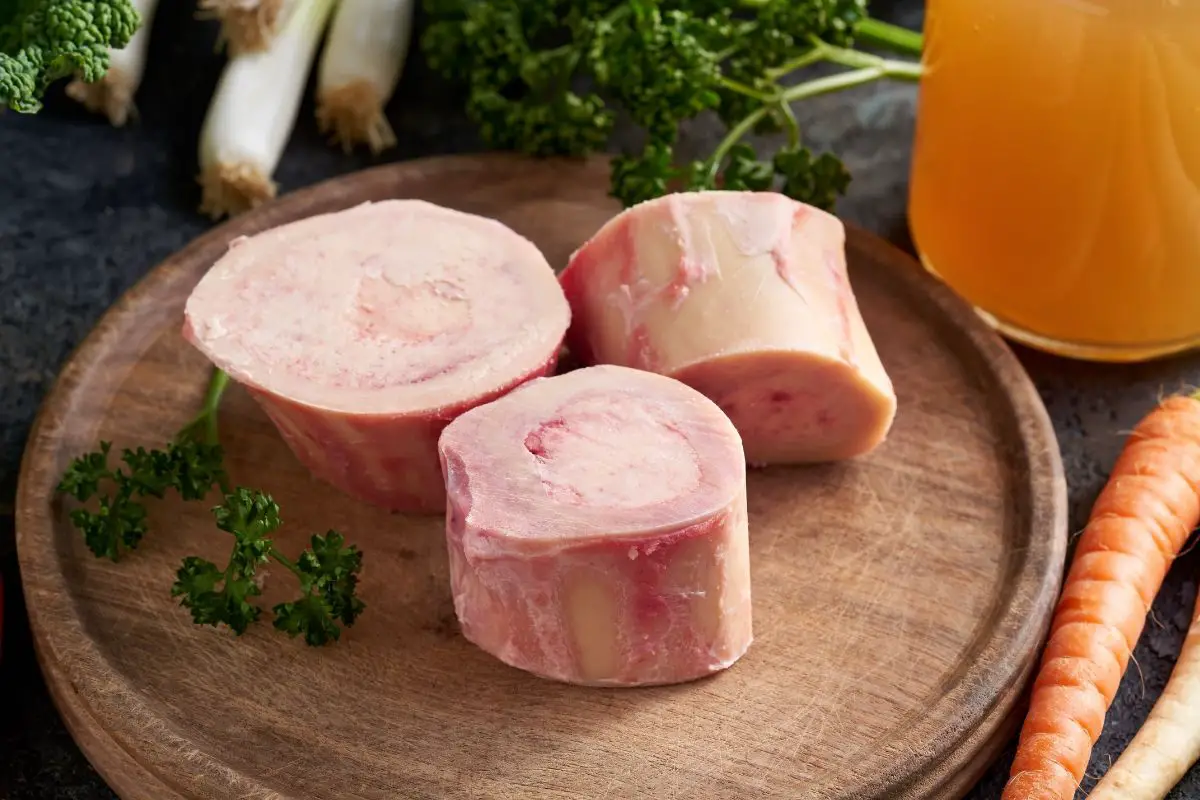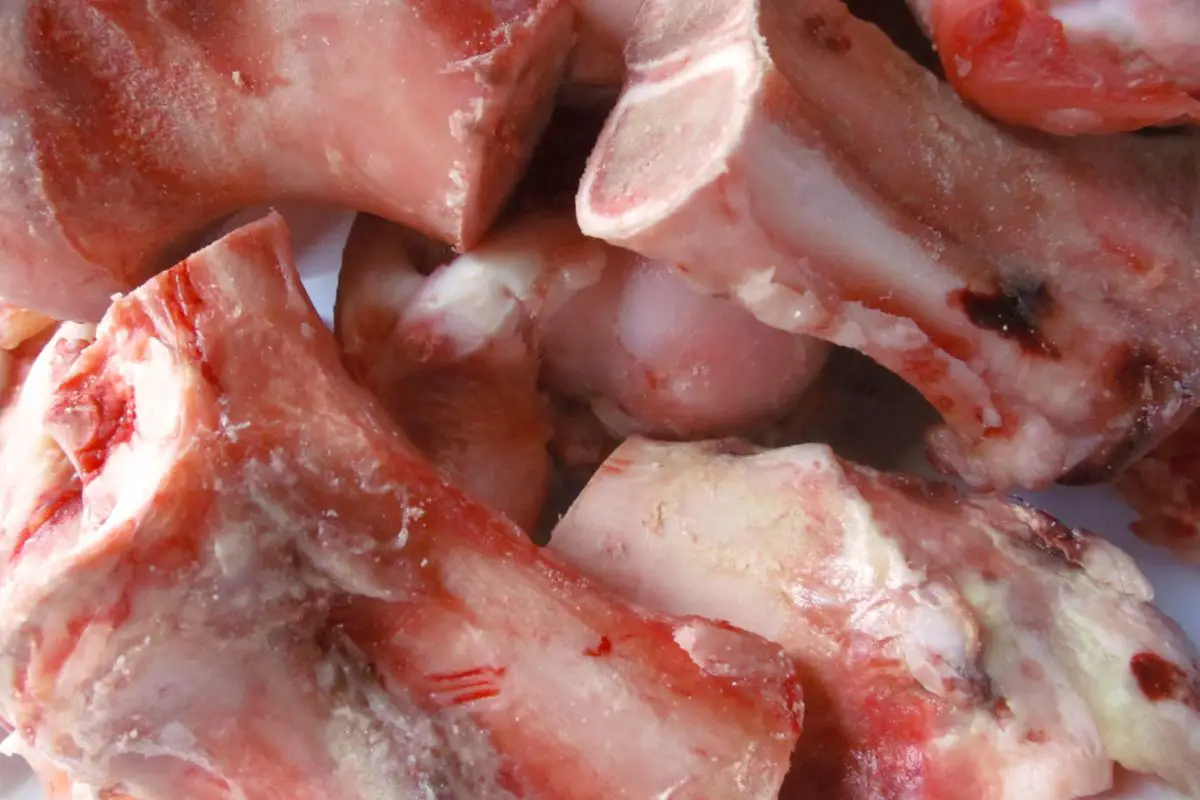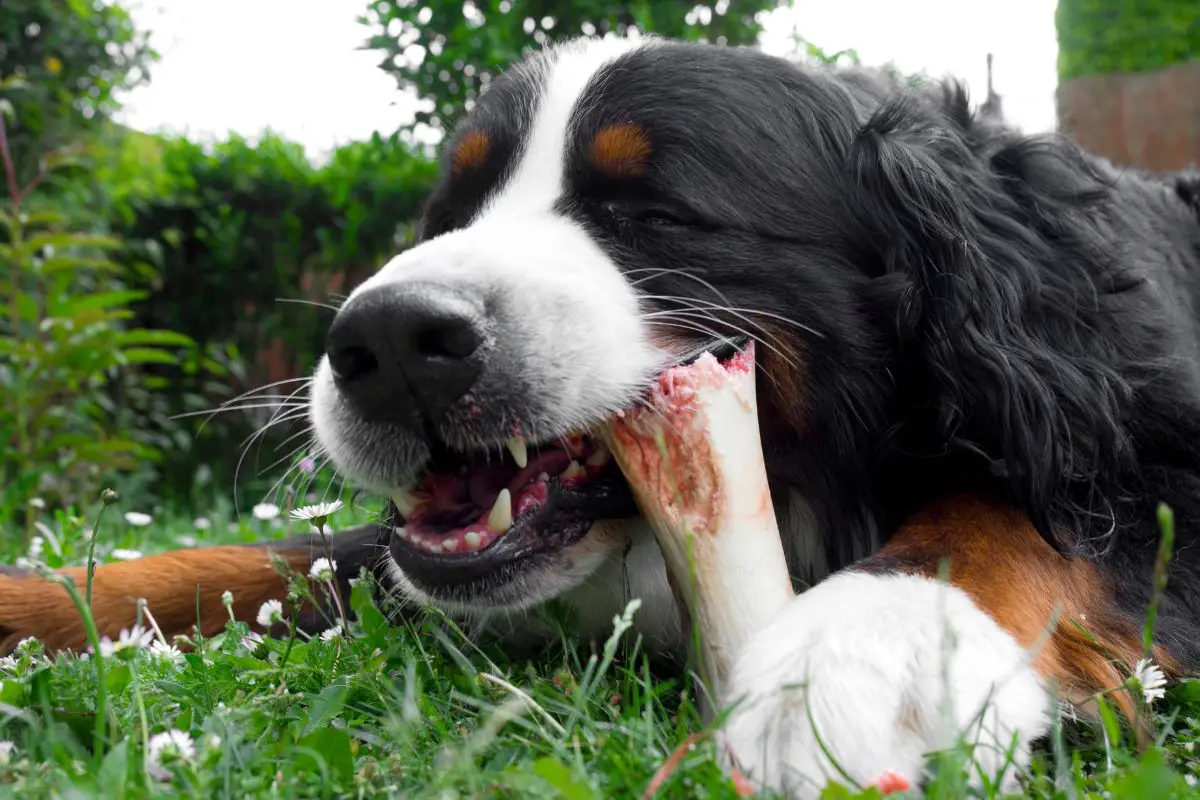Cartoon dogs are forever drooling over big, juicy bones before burying them in the yard for a wholesome gnawing session at a later date, much to the chagrin of their fictional owners, but can real dogs also safely partake in a marrow bone or two?

I know you probably came here looking for a quick answer, but it’s more of a complex topic than you might at first think. Honestly, whether marrow bones are safe for dogs depends on who you ask.
However, one thing I can say for sure right here, right now is that cooked bones are strictly out of the question.
Raw bones, on the other hand, are potentially safe, so let’s take a look at some of the back and forth on the subject so you can make an informed decision on behalf of your pooch.
Are Raw Marrow Bones Safe For Dogs?
There are a number of pros and cons to giving your dog a juicy marrow bone to chew on from time to time, meaning whether a dog is given this type of treat comes down to the discretion of the owner — Here are the main considerations to keep in mind.
What Are The Benefits Of Giving Marrow Bones To Dogs?
One of the best arguments for giving our pooches marrow bones is that, in the wild, they would be consuming bones on a regular basis, and it never does any of their wolfy cousins any harm.
In fact, marrow bones are chock-full of essential nutrients, such as calcium and phosphorus that help to keep our furry family members in tip-top shape!
Your dog will also get plenty of proteins and B12 from a marrow bone, aiding muscle development, encouraging healthy joints, and producing a thick, lustrous coat.
What’s more, chomping down on bones is a fantastic way for dogs to keep their teeth clean, and anything that keeps those chaotic sessions with a toothbrush at bay is a winner in my book!
What Are The Drawbacks Of Giving Marrow Bones To Dogs?
Not all bones are made equal. Larger bones sculpted to bear weight, such as femurs and hip bones, are much stronger than smaller bones, which can wind up causing more dental issues than they solve.
Our dogs’ teeth simply aren’t strong enough to tackle such robust bones and are liable to chip, fracture, or fall out if our pooches get their jowls on one.
Sticking to lighter, smaller bones is the golden rule of treating your dog with marrow bones. No dog owner in their right mind would suggest using heavy leg or hip bones from a cow, even if they swear by giving dogs bones in general.
Having said that, going too small can be an issue too, as they present a choking hazard, so, as you can see, it’s all about finding a balance between bone size and bone strength.
But even if your bone lands right in the sweet spot, there might still be complications.
The worry is that sharp fragments of the bones could splinter off under the pressure of a dog’s bite and end up doing some nasty damage to their mouth, throat, or digestive system.
What’s more, as marrow bones have comparatively high caloric and fat content, they’re not a particularly good option for chunky dogs that need a lean diet, or dogs with certain kidney problems.
How To Reduce Risk When Giving Your Dog A Marrow Bone
I know that you’re probably feeling a little spooked after hearing about all the things that can go wrong when you give your dog a marrow bone, but thankfully, there are measures you can take to minimize potential hazards.
- Find the perfect size bone — As mentioned earlier, finding the correct size bone for your dog is crucial.
- Stay with your dog while they chew on their bone — Not much can go wrong if you’re right there with your dog, monitoring their snack time.
- When the marrow’s gone, take the bone away — The moment your happy doggo licks away that last bit of marrow in the bone, take it away and discard it. They might throw a bit of a tantrum, but removing the remains eliminates the chance of splinters making their way into their digestive system.

Do Marrow Bones Have A Shelf Life?
While you likely won’t find an expiration date printed on a marrow bone, much like anything, they will go bad eventually, especially after being slobbered on in a warm environment.
In light of this, you should really only ever give your dog a day to excavate all the juicy marrow, max.
Any longer than that and the marrow will start attracting flies looking to lay eggs, and the bone itself will start to lose moisture, increasing the chance of splinters.
Is Freezing Marrow Bones An Option?
Yep, if you want to stock up on marrow bones ahead of time, you can indeed freeze them.
But even though there are a number of owners that say the bone thaws well enough once covered in warm slobber, it’s always safer to defrost a marrow bone before giving it to your dog.
A frozen bone is a harder bone, which can cause havoc in the dental department. In addition, many dogs don’t enjoy the extra hassle of softening the tissue before slurping the marrow out.
How Do You Defrost Marrow Bones?
I’d recommend thawing the marrow bone exactly as you would if you planned to use it for cooking: on a dish in the refrigerator for about 24 hours.
Should I Cook A Marrow Bone Before Giving It To My Dog?
Unless you’re whipping up some hearty bone broth for your pooch, you don’t need to worry about cooking a marrow bone, as cooked bones are far more likely to splinter and fracture, which, as discussed, is a real issue.
Besides, it’s not like our dogs are fussy eaters. They’ll take some raw marrow without blinking an eye or twitching their snout.
What Is Bone Broth?
Bone broth is essentially just a very simple stock that you’ll feed to your dog instead of using for a soup or gravy.
You can make it by boiling some marrow bones up until all the lovely nutrients seep out into the water. Remove the bones and serve the juices up to your dog as a healthy, risk-free treat.
Where Can I Get Some Marrow Bones?
I’ve no doubt that numerous people out there have no clue how they’d source bones for their dog without engaging in some questionable activities, but they’re actually remarkably easy to get hold of.
If there are any butchers nearby, they might offer you some for free, but this puts the onus on you to decide if the size and type of the bone is suitable for your dog.
For an easier approach, you can simply order a number of different types of marrow bone online or pick some up from your local pet store. These will be carefully curated treats, so you won’t have to worry about finding particular sizes.
How Often Can I Give My Dog Marrow Bones?
Due to their calorific nature, if you do decide to give your dog marrow bones, it’s best to keep them as a once every so often treat rather than an everyday treat.
Not only can overfeeding a dog marrow bones lead to canine obesity, it can upset their stomachs, and you know what happens then — Clean up on aisle your couch, am I right?
Giving your dog a marrow bone about once a month is a healthy amount, or once every other month if you really want to play it safe.
How Long Should My Dog Chew A Marrow Bone At A Time?
It’s good to allow your dog about 30 minutes to chew on a marrow bone. After that, a small break will be good for your dog and you, as you won’t have to observe your pooch for a while.
You can always give the bone back in 10–20 minutes so they can have another chomp — Remember, marrow bones last for about a day, so there’s plenty of time for your dog to get through one, even with breaks.
How Old Should A Dog Be Before You Give Them A Marrow Bone?
Generally speaking, veterinarians and pet nutritionists will recommend holding off giving your dog marrow bones until they’re at least 6 months old, as at this point, their digestive system can handle the richness of the marrow, and all their adult teeth have probably come in.
But don’t just take it as a given that your pup’s teeth are up to the marrow bone challenge as soon as they turn 6 months, as some dogs’ adult teeth don’t arrive until around their first birthday.

Will Marrow Bones Upset My Dog’s Stomach?
Giving any dog too many marrow bones will cause stomach upset, but, just like humans, sometimes dogs can have sensitive bellies, meaning what is normally considered a healthy amount of marrow bone treats might make them quite ill as well.
That’s not to say that they should never have marrow bones, but it should be a strictly limited treat.
How Big Should A Marrow Bone Be?
Suitably sized marrow bones should be around the same size as your dog’s head, but remember, size isn’t everything. You should also consider the type of bone, as weight-bearing bones are too strong for dogs to chew on safely.
Should I Give My Dog A Marrow Bone In Or Outside?
There’s nothing wrong with letting your dog gnaw on a marrow bone outside, even if it gets a little dirty, but you should make sure that they don’t try to bury it for consumption later, as this can lead to a number of nasty health issues (and a decimated yard).
Are There Any Alternatives To Marrow Bones?
Although it’s relatively safe to give your dogs marrow bones if you follow certain precautions, we can’t always be around to supervise them, especially if they like to take their sweet time sucking out all that yummy marrow, so sometimes, a safer alternative is required.
Food Alternatives
If you want to replace marrow with another foody treat, you have a few options:
- Rabbits ears
- Fish skin (the crunchy kind)
- Antlers — Although, these pose many of the same risks as marrow bones do, so I can’t recommend using them as a safe alternative when you’re not around to supervise.
Toy Alternatives
In my opinion, the best alternative to marrow bones is this awesome dental toy with a reservoir for either treats or toothpaste.
With one of these in your toy arsenal, you can safely replace a marrow bone without disappointing your dog!
As for what treats to put in the reservoir, I’d stick to whatever your dog likes best, but I find that doggy pate makes for a pretty realistic marrow substitute.
Just be mindful that you don’t overtreat your dog using this toy. The last thing you want is for your dog to develop health problems due to overeating.
Final Thoughts: Safe Practice Recap
We’re pretty much done here, but before we go our separate ways, let’s recap all the key marrow bone takeaways:
- You should never leave your dog alone with a marrow bone.
- Marrow bones should be the right size (usually about the size of your dog’s head)
- Marrow bones should not be weight-bearing, as they can break your dog’s teeth.
- You can freeze marrow bones, but they must be defrosted before being given to your dog.
- You should never cook marrow bones unless you’re making a bone broth and discarding the bones after the fact.
- Your dog can chew marrow bones outside but should not be permitted to bury them or dig them back up at a later date.
- High in fat and calories, it’s best to keep marrow bones as a special, once-a-month treat.
- Take an unfinished marrow bone away at 30-minute intervals to give your dog a break.
- Marrow bones last for about a day before they should be thrown out.
With all this top info in mind, you can rest assured that treating your dog to a marrow bone won’t end in disaster! Bone appétit.
- Are Antlers Safe For Dogs? - January 14, 2024
- Can Dogs Eat Honey Nut Cheerios? - December 23, 2023
- Natural Deworming Remedies for Your Dog - December 18, 2023









